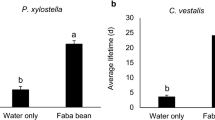Abstract
Apolygus lucorum (Heteroptera: Miridae), a polyphagous mirid bug, often shows a strong preference for flowering host plants. It is hypothesized that host plant selection by phytophagous insects results in a variety of behavioral trade-offs. In this study, the relationship between adult preference and nymphal performance was examined on host plants with their flowers left intact and with flowers removed to investigate potential trade-offs in A. lucorum’s preference for flowering plants. Field trials in 2010 and 2011 showed that adults and nymphs were significantly more abundant on plants with flowers left intact than on those with flowers removed, while oviposition choice trials in field cages revealed that female adults preferred to lay eggs on plants with flowers. Laboratory performance trials demonstrated that adult lifespan and fecundity and nymphal development rate and survival were all significantly higher on plants with flowers compared with plants without flowers. In contrast, sex ratio was not significantly different. Simple linear regression analysis showed positive correlations between (1) adult and nymphal abundances in the field, (2) nymphal development rates and survival with adult fecundity in the laboratory, and (3) adult lifespan with fecundity in the laboratory. Since a positive preference–performance correlation was found for A. lucorum, we conclude that there are no evident behavioral trade-offs for host plant selection by this polyphagous mirid bug.




Similar content being viewed by others
References
Berdegué M, Reitz SR, Trumble JT (1998) Host plant selection and development in Spodoptera exigua: do mother and offspring know best? Entomol Exp Appl 89:57–64
Chen ZC, Su L, Ge F, Su JW (2010) Electroantennogram responses of the green leaf bug, Lygus lucorum Meyer-Dür (Hemiptera: Miridae), to sex pheromone analogs and plant volatiles. Acta Entomol Sin 53:47–54
Chu HF, Meng HL (1958) Studies on three species of cotton plant bugs, Adelphocoris taeniophorus Reuter, A. lineolatus (Goeze), and Lygus lucorum Meyer-Dür (Hemiptera: Miridae). Acta Entomol Sin 8:97–118
Courtney SP (1981) Coevolution of pierid putterflies and their cruciferous food plants. Oecologia 51:91–96
Dong JW, Lu YH, Yang YZ (2012) Oviposition behavior of adult female Apolygus lucorum. Chin J Appl Entomol 49:591–595
Firempong S, Zalucki MP (1990) Host plant selection by Helicoverpa armigera (Hübner) (Lepidoptera: Noctuidae); role of certain plant attributes. Aust J Zool 37:675–683
Fleischer SJ, Gaylor MJ (1987) Seasonal abundance of Lygus lineolaris (Heteroptera: Miridae) and selected predators in early season uncultivated hosts: implications for managing movement into cotton. Environ Entomol 16:379–389
Geng HH, Pan HS, Lu YH, Yang YZ (2012) Nymphal and adult performance of Apolygus lucorum (Hemiptera: Miridae) on a preferred host plant, mungbean Vigna radiata. Appl Entomol Zool 3:191–197
Gripenberg S, Mayhew PJ, Parnell M, Roslin T (2010) A meta-analysis of preference-performance relationships in phytophagous insects. Ecol Lett 13:383–393
Institute SAS (2005) SAS/STAT user’s guide. SAS Institute, Cary
Jaenike J (1978) On optimal oviposition behaviour in phytophagous insects. Theor Popul Biol 14:350–356
Jaenike J (1986) Feeding behavior and future fecundity in Drosophila. Am Nat 127:118–123
Kullenberg B (1944) Studien iiber die Biologie der Capsiden. Zool Bidrag Uppsula 23:1–522
Kursar TA, Wolfe BT, Epps MJ, Coley PD (2006) The effects of plant quality, food availability, competition, and parasitism on performance and diet electivity in tropical Lepidoptera feeding on Inga (Fabaceae). Ecology 87:3058–3069
Liu ZD, Scheirs J, Heckel DG (2010) Host plant flowering increases both adult oviposition preference and larval performance of a generalist herbivore. Environ Entomol 39:552–560
Lu YH, Wu KM (2008) Biology and control of the mirids. Golden Shield Press, Beijing
Lu YH, Qiu F, Feng HQ, Li HB, Yang ZC, Wyckhuys KAG, Wu KM (2008a) Species composition and seasonal abundance of pestiferous plant bugs (Hemiptera: Miridae) on Bt cotton in China. Crop Prot 27:465–472
Lu YH, Wu KM, Cai XM, Liu YQ (2008b) A rearing method for mirids using the green bean, Phaseolus vulgaris in the laboratory. Acta Phytophyl Sin 35:251–269
Lu YH, Wu KM, Wyckhuys KAG, Guo YY (2009) Potential of mungbean, Vigna radiatus as a trap crop for managing Apolygus lucorum (Hemiptera: Miridae) on Bt cotton. Crop Prot 28:77–81
Lu YH, Wu KM, Jiang YY, Xia B, Li P, Feng HQ, Wyckhuys KAG, Guo YY (2010) Mirid bug outbreaks in multiple crops correlated with wide-scale adoption of Bt cotton in China. Science 328:1151–1154
Mayhew PJ (1997) Adaptive patterns of host-plant selection by phytophagous insects. Oikos 79:417–428
Nylin S, Janz N (1996) Host plant preferences in the comma butterfly (Polygonia c-album): do parents and offspring agree? Ecoscience 3:611–612
Santos JC, Silveira FAO, Fernandes GW (2008) Long term oviposition preference and larval performance of Schizomyia macrocapillata (Diptera: Cecidomyiidae) on larger shoots of its host plant Bauhinia brevipes (Fabaceae). Evol Ecol 22:123–137
Scheirs J, De Bruyn L (2002) Integrating optimal foraging and optimal oviposition theory in plant-insect research. Oikos 96:187–191
Scheirs J, De Bruyn L, Verhagen R (2000) Optimization of adult performance determines host choice in a grass miner. Proc R Soc Lond B 267:2065–2069
Schoonhoven LM, van Loon JJA, Dicke M (2005) Insect-plant biology, 2nd edn. Oxford University Press, New York
Thompson JN (1988) Evolutionary ecology of the relationship between oviposition preference and performance of offspring in phytophagous insects. Entomol Exp Appl 47:3–14
Wäckers FL, Romeis J, van Rijn P (2007) Nectar and pollen feeding by insect herbivores and implications for multitrophic interactions. Annu Rev Entomol 52:301–323
Wheeler AG Jr (2001) Biology of the plant bugs (Hemiptera: Miridae): pests, predators, opportunists. Cornell University Press, Ithaca
Acknowledgments
We thank the editor and two anonymous reviewers for their valuable comments. This research was supported by the National Natural Science Funds (No. 30900949), the National Basic Research Program of China (No. 2012CB114104).
Author information
Authors and Affiliations
Corresponding author
Additional information
Handling Editor: Gimme Walter.
Rights and permissions
About this article
Cite this article
Dong, JW., Pan, HS., Lu, YH. et al. Nymphal performance correlated with adult preference for flowering host plants in a polyphagous mirid bug, Apolygus lucorum (Heteroptera: Miridae). Arthropod-Plant Interactions 7, 83–91 (2013). https://doi.org/10.1007/s11829-012-9222-3
Received:
Accepted:
Published:
Issue Date:
DOI: https://doi.org/10.1007/s11829-012-9222-3




